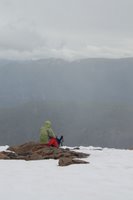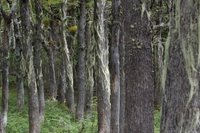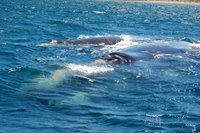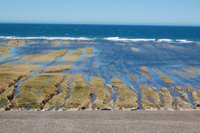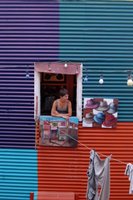
Having landed at Puerto Madryn in 1865 to establish a New Wales, the settlers headed inland following the Chubut river. At Gaiman, they established a small town with brick chapels where Sunday service is still observed in Welsh. The first few years of their existence in Argentina were tough and it was only with the assistance of the local Indians, whom the Welsh befriended rather than fought, that they managed to grow crops and survive.

The tourists don´t flock to Gaiman for the lively nightlife, rather for the tradition of Welsh tea - a plate of seven or eight different types of cake and a huge pot of tea served by women who wouldn´t be out of place in a Welsh farm kitchen. We both felt sick by the end, but awarded equal first place to the apple pie and bara brith. As we waited for the evening bus, a tray of cherries caught Albane´s eye and we rounded off a day of eating with a bag, spitting the pips into the river and wishing them luck in making an orchard downstream.

The next day, we arrived at Esquel, 8 hours in a bus to the east, and, in the glorious first light of dawn, saw snow-capped mountains. The air was fresh and I felt excited to be back in the Andes. We spent the day buying food for our planned trip to the nearby national park and, in the evening, stumbled on a concert by Gruff Rhys, lead singer of the Super Furry Animals. In a Welsh Sunday school with 50 other people, we drank beer and relied on the Spanish translation of what he was saying in Welsh. Slightly embarassing for a Welshman! A cross between Jim Morrison and James Blunt, he looped sounds and his voice to create multi-layered songs, some of which challenged the musical tastes of the Welsh-speaking Argentinian grannies.

Los Alerces naional park is, as the name suggests, renowned for Alerces, a native tree which can grow to an age of 3,500 years old. Access to the remote regions of the park where these monsters grow is restricted due to the high fire risk in the region, but there are a number of trails open to walkers and, having registered our destination as Playa Blanca, we headed along the shore of Lago Futalaufquen through fragrant woodland.
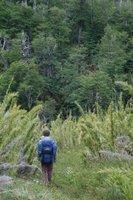
The last time we had carried full rucsacs was on the Isla del Sol in Lake Titicaca two months ago. Since then, we have eaten far too much ice cream and red meat and exercised far too little, so the steep 2 hour climb to the windy pass at 1,500 metres was tough. We slipped into silence and our own little worlds as we put one foot in front of the other and ascended through forests of bamboo. High above us in the main canopy of the forest, we could hear the screaming wind and when we reached the top, we had to put on windproofs as our sweat cooled and we started to shiver. It had taken almost 5 hours of walking to reach the top and Albane admitted to me later that she had wondered to herself why she was doing it.

However, when we crested the pass and the land started to drop away, we found the explanation. As simple as the huge vista in front of us was beautiful. As far as we could see, there were ranges of jagged, snow-capped mountains, dark lakes whipped into white horses by the wind, swathes of dark green forest cloaking the landscape and not a sign of human existence. We huddled behind a boulder and stared at the view until the cold got to us and we were forced to descend down a viciously steep path for an hour, our toes slipping uncomfortably to the front of our boots, to reach a small beach.

To our joy, Playa Blanca was the dream destination - a perfect campsite on flat ground amongst the trees, a log to sit on while we cooked and a pebble beach. We were hot and sweaty after the descent and stripped off before diving into the clear water. It was cold, but refreshing and, when we could bear the temperature no longer, we lay on the hot pebbles to dry. There was no one else within 5 hours´walk and it was an unforgettable moment of the trip.

The next day, with bamboo staffs in each hand, we climbed back to the pass and ran screaming through the scrub when the wind dropped and swarms of large, ravenous horseflies bombarded us. We arrived back at the trailhead in the late afternoon and walked to the bus stop where, after an ice cream (some habits die hard), we bounced back to Esquel.
 Pucon is the Chilean capital of adventure sports (so it claims) and, after running the gauntlet of the myriad of tour agencies, we settled on the small office of Kayak Pucon, run by a freidnly blonde-haired Italian and her Chilean boyfriend, Rodrigo. The photos of him kayaking off waterfalls were presumably meant to reassure us that he knew his stuff, but served only to warn us that he was a little crazy.
Pucon is the Chilean capital of adventure sports (so it claims) and, after running the gauntlet of the myriad of tour agencies, we settled on the small office of Kayak Pucon, run by a freidnly blonde-haired Italian and her Chilean boyfriend, Rodrigo. The photos of him kayaking off waterfalls were presumably meant to reassure us that he knew his stuff, but served only to warn us that he was a little crazy.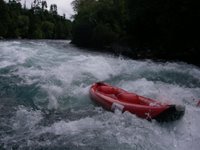 Albane was keen to get wet (the last 10 days of rain apparently didn´t count) and, undeterred by the name, we signed up to the ducky trip. Duckies are bright red inflatable kayaks which can be paddled, after 10 minutes of instruction, by novices. Armed with just a paddle, wetsuit, helmet and buoyancy aid, the authorities that regulate outdoor sports in Chile (if any exist) allow tourists to descend the whitewater rivers that spill from the mountains around Pucon.
Albane was keen to get wet (the last 10 days of rain apparently didn´t count) and, undeterred by the name, we signed up to the ducky trip. Duckies are bright red inflatable kayaks which can be paddled, after 10 minutes of instruction, by novices. Armed with just a paddle, wetsuit, helmet and buoyancy aid, the authorities that regulate outdoor sports in Chile (if any exist) allow tourists to descend the whitewater rivers that spill from the mountains around Pucon. The January rush of tourists had not started (it still being December) and there were only the two of us plus Rodrigo on the tour. We drove 20 minutes out of town and unloaded in a meadow beside a clear river flowing gently, but purposefully. We donned our kit and launched in the big red inflatables. Rodrigo gave us 10 minutes of instruction about how to turn and what to do if we found ourselves in the water, rather than the boat. It would be useful for both of us.............
The January rush of tourists had not started (it still being December) and there were only the two of us plus Rodrigo on the tour. We drove 20 minutes out of town and unloaded in a meadow beside a clear river flowing gently, but purposefully. We donned our kit and launched in the big red inflatables. Rodrigo gave us 10 minutes of instruction about how to turn and what to do if we found ourselves in the water, rather than the boat. It would be useful for both of us.............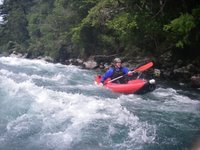 We drifted downstream past small fields, wooden houses on stilts and the odd fisherman casting for trout. The first rapid, a rushing roller coaster where the river was squeezed in a narrow gorge, appeared quickly and, halfway down, one of the waves caught Albane by surprise and she was pitched into the cold water. The temperature and the sucking power of the current shocked her, but she found her boat quickly and managed to pull herself back into the cockpit. A big smile suggested that she was enjoying herself.
We drifted downstream past small fields, wooden houses on stilts and the odd fisherman casting for trout. The first rapid, a rushing roller coaster where the river was squeezed in a narrow gorge, appeared quickly and, halfway down, one of the waves caught Albane by surprise and she was pitched into the cold water. The temperature and the sucking power of the current shocked her, but she found her boat quickly and managed to pull herself back into the cockpit. A big smile suggested that she was enjoying herself. We ran rapids followed by calm pools where we could regain our compsure with Rodrigo casually drifting beside us taking the obligatory "I did the duckies" photos. It was fun, really good fun, with the manouevrable boats, cool water and stunning views. The river curved between banks of volcanic ash, the layers marking past eruptions, and green woodland. The water was so clear that we could see the pebbly river bed 2 metres beneath us as if it were in touching distance.
We ran rapids followed by calm pools where we could regain our compsure with Rodrigo casually drifting beside us taking the obligatory "I did the duckies" photos. It was fun, really good fun, with the manouevrable boats, cool water and stunning views. The river curved between banks of volcanic ash, the layers marking past eruptions, and green woodland. The water was so clear that we could see the pebbly river bed 2 metres beneath us as if it were in touching distance.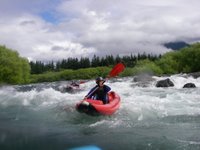 We paddled for an hour or so before we reached the get out point. I couldn´t resist asking Rodrigo if I could try to roll his kayak. It had been 6 years or more since I had been in a kayak and I wanted to know if I could still do it. His eyes sparkled and he smiled as he passed me the spraydeck. I squeezed into the small boat and, without thinking about it, rolled. It was simple, like a deep wired reaction to the kayak tipping over. I rolled a few more times and Rodrigo laughed that my roll was better than his. I was not foooled by his nonchalance.
We paddled for an hour or so before we reached the get out point. I couldn´t resist asking Rodrigo if I could try to roll his kayak. It had been 6 years or more since I had been in a kayak and I wanted to know if I could still do it. His eyes sparkled and he smiled as he passed me the spraydeck. I squeezed into the small boat and, without thinking about it, rolled. It was simple, like a deep wired reaction to the kayak tipping over. I rolled a few more times and Rodrigo laughed that my roll was better than his. I was not foooled by his nonchalance.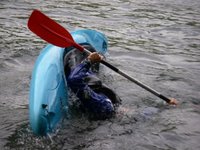 The trip had been great fun and Albane, who usually feels the cold more than anyone, surprised me by wishing that the descent had been a little longer. But then, like all such things, it is always better if you are left wanting more.
The trip had been great fun and Albane, who usually feels the cold more than anyone, surprised me by wishing that the descent had been a little longer. But then, like all such things, it is always better if you are left wanting more.



